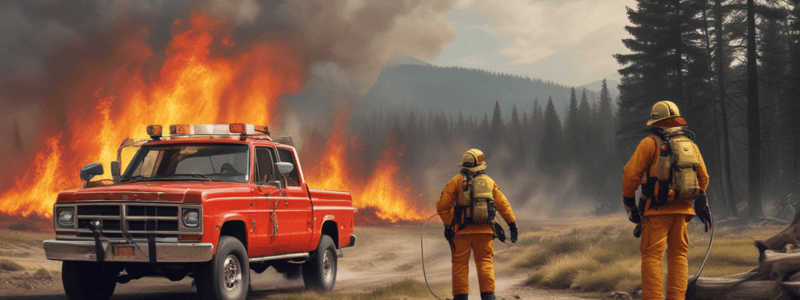Podcast
Questions and Answers
What is the primary purpose of Brush 24 (BT24) according to the Standard Operating Guidelines?
What is the primary purpose of Brush 24 (BT24) according to the Standard Operating Guidelines?
- To assist in extinguishment of wildland fires (correct)
- To transport personnel to emergency incidents
- To inspect equipment on a weekly basis
- To conduct hose testing
How often should Brush 24 (BT24) be checked out when in quarters?
How often should Brush 24 (BT24) be checked out when in quarters?
- Daily
- Monthly
- Weekly (correct)
- Quarterly
What should be done to the water tank after using the water pump for inspection, training or an incident?
What should be done to the water tank after using the water pump for inspection, training or an incident?
- It should be filled (correct)
- It should be drained
- It should be left as is
- It should be inspected
When can Brush 24 (BT24) be used?
When can Brush 24 (BT24) be used?
How often should the vehicle and water pump be inspected and tested?
How often should the vehicle and water pump be inspected and tested?
What is NOT a proper use of Brush 24 (BT24)?
What is NOT a proper use of Brush 24 (BT24)?
Who has approved this Standard Operating Guidelines?
Who has approved this Standard Operating Guidelines?
How many pages does this Standard Operating Guidelines contain?
How many pages does this Standard Operating Guidelines contain?
What should you avoid using when winching?
What should you avoid using when winching?
How long should you wait before using the winch again after it stalls during operation?
How long should you wait before using the winch again after it stalls during operation?
What should you do when driving up or down a hill or slope?
What should you do when driving up or down a hill or slope?
What should you do when descending a hill?
What should you do when descending a hill?
Who must remain in the vehicle when winching the apparatus?
Who must remain in the vehicle when winching the apparatus?
What is the minimum trunk diameter of a tree that can be used as a stationary object?
What is the minimum trunk diameter of a tree that can be used as a stationary object?
What should you inspect before each use of a winch?
What should you inspect before each use of a winch?
What should you do to hold the vehicle in place during winching?
What should you do to hold the vehicle in place during winching?
What should you do to the winch cable when returning the apparatus to service?
What should you do to the winch cable when returning the apparatus to service?
What is the maximum tongue weight that can be loaded on the towing bracket?
What is the maximum tongue weight that can be loaded on the towing bracket?
Why is it important to keep the winch cable aligned with the centerline of the winching vehicle?
Why is it important to keep the winch cable aligned with the centerline of the winching vehicle?
What is the minimum number of full turns of winch cable that should be wrapped around the winch drum at all times?
What is the minimum number of full turns of winch cable that should be wrapped around the winch drum at all times?
What should you do when towing a disabled vehicle?
What should you do when towing a disabled vehicle?
What is the purpose of a damper in winch operation?
What is the purpose of a damper in winch operation?
Why should you not tow more than the recommended weight?
Why should you not tow more than the recommended weight?
What should you avoid doing when hooking up a winch cable?
What should you avoid doing when hooking up a winch cable?
What is a key consideration when unlocking the rear differential?
What is a key consideration when unlocking the rear differential?
Which of the following actions should be avoided when operating in TURF mode?
Which of the following actions should be avoided when operating in TURF mode?
What is recommended to do before traversing water?
What is recommended to do before traversing water?
Which practice should be avoided for maintaining steering control on rough terrain?
Which practice should be avoided for maintaining steering control on rough terrain?
Which hazard should be avoided when driving on hills or inclines?
Which hazard should be avoided when driving on hills or inclines?
What should be done after leaving the water?
What should be done after leaving the water?
When should a spotter be considered during off-road driving?
When should a spotter be considered during off-road driving?
What is advised against when driving over a crest of a hill?
What is advised against when driving over a crest of a hill?
What should be done before engaging all-wheel drive (AWD) in a situation where front wheel drive may be needed?
What should be done before engaging all-wheel drive (AWD) in a situation where front wheel drive may be needed?
What indicates that the vehicle is currently in all-wheel drive (AWD)?
What indicates that the vehicle is currently in all-wheel drive (AWD)?
What could happen if AWD is engaged while the rear wheels are spinning?
What could happen if AWD is engaged while the rear wheels are spinning?
When disengaging AWD, what is the first action that should be taken?
When disengaging AWD, what is the first action that should be taken?
If the front hubs do not release immediately after turning off the AWD switch, what is the next best step?
If the front hubs do not release immediately after turning off the AWD switch, what is the next best step?
What is NOT a requirement when locking the differential to operate in two-wheel drive (2WD)?
What is NOT a requirement when locking the differential to operate in two-wheel drive (2WD)?
How does locking the differential affect the vehicle's performance?
How does locking the differential affect the vehicle's performance?
What is the result of stopping the vehicle before disengaging the AWD in specific conditions?
What is the result of stopping the vehicle before disengaging the AWD in specific conditions?
Flashcards are hidden until you start studying
Study Notes
Brush 24 (BT24) Operations
Purpose
- Assist in extinguishing wildland fires and safe transportation of personnel
- Can be used for various emergency incidents beyond wildland fires
Policy
- Operate Brush 24 in a safe and efficient manner according to these Standard Operating Guidelines
Procedure
A. Storage and Transportation
- When in quarters, Brush 24 is secured on its trailer and checked out weekly
- If requested by CAD, Brush 24 is secured to its trailer, connected to CAR4 or an appropriate tow vehicle, and responds according to Response Guideline-17 Brush Fire
B. Dry Pump and Tank
- Keep pump and tank dry when in quarters
- Fill water tank and prime pump if used for inspection, training, or an incident
- Do not use Brush 24 for hose testing
- Inspect and test vehicle and water pump every Thursday of the month
C. Operation of Water Pump
- Shifting to All-Wheel Drive (AWD):
- Engage AWD before entering conditions where front-wheel drive may be needed
- Press the top of the switch to engage AWD
- 4X4 indicator illuminates in the rider information center to indicate AWD engagement
- Front gearcase automatically engages when rear wheels lose traction and disengages when regaining traction
- No limit to the length of time the vehicle remains in AWD
- WARNING: Switching to AWD while rear wheels are spinning may cause severe drive shaft and clutch damage
D. Disengaging All-Wheel Drive (AWD)
- Slow the vehicle to nearly stopped before disengaging AWD
- Move the AWD switch to the center or bottom position to disengage AWD
- If the switch is turned off while the front hubs are driving, they will not release until the rear wheels regain traction
F. Locking the Differential (2WD)
- Bring the vehicle to a stop before engaging the differential
- Move the rocker switch to the center position to lock the differential and operate in two-wheel drive (2WD)
- Locking the differential in slippery or low-traction conditions improves traction
G. Unlocking the Differential (1WD/Turf Mode)
- Slow the vehicle to nearly stopped before unlocking the differential
- Operate in Turf mode only as needed to protect smooth, level surfaces from tire damage
- Do not operate in Turf mode when climbing/descending hills, side-hilling, or on uneven/loose/slippery terrain
I. Driving Off-Road
- Drive slowly and cautiously
- Maintain steering wheel control at all times, especially in rough terrain
- Avoid driving into deep mud, sand, and swampy areas
- Consider using a spotter when driving into these areas
- Always drive straight up/down an incline
- Avoid driving crosshill or turning on steep slopes/hills
J. Winch Operation
- Inspect the vehicle, winch, winch cable, and winch controls for damage or needed repairs before each use
- Apply the vehicle's park mechanism to hold the vehicle in place during winching
- Keep the winch cable aligned with the centerline of the winching vehicle
- Release the winch clutch and pull out the winch cable
- Always wrap at least five full turns of winch cable around the winch drum
- Use a "damper" on the midpoint of the winch cable to absorb energy released by a winch cable failure
K. Towing Loads
- Never load more than 150 lbs (68.1 kg) tongue weight on the towing bracket
- When towing a disabled vehicle, place the disabled vehicle's transmission in neutral
- Do not operate the vehicle faster than 10 MPH (16 km/h) when towing
- Towing a trailer increases braking distance
- Do not tow more than the recommended weight for the vehicle
- Attach a trailer to the trailer hitch bracket only
Studying That Suits You
Use AI to generate personalized quizzes and flashcards to suit your learning preferences.



